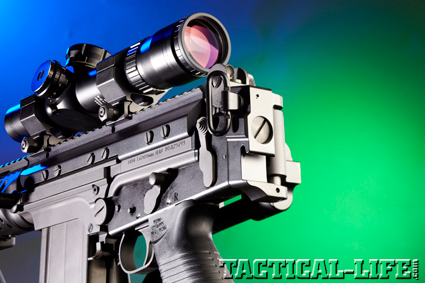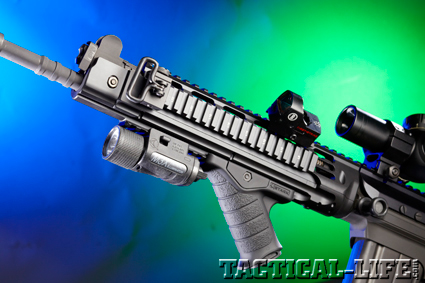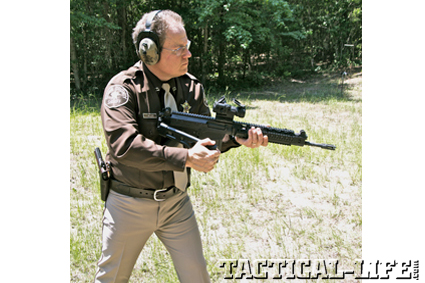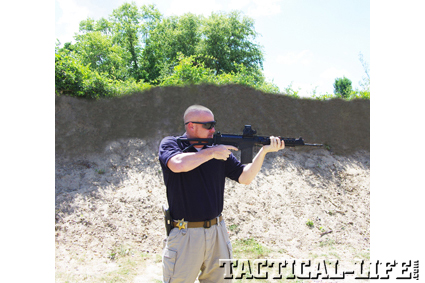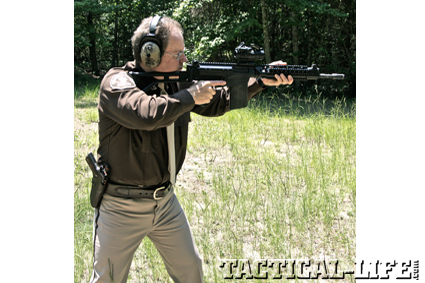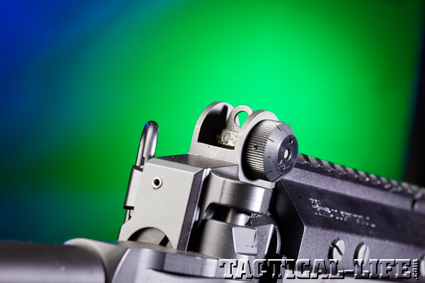The history of the FN FAL is replete with stories of hard men who chose the 7.62x51mm NATO-chambered rifle, officially Fabrique Nationale’s Fusil Automatique Léger or “Light Automatic Rifle,” when lives depended on their successes. Not because it was all they had, but because it was considered by experts—those same hard men—to be the best available.
In current times, FN FAL admirers always seem to have a moment they can point to that led to developing their burgeoning love of this famous rifle. And, that affection has carried the popularity of the FAL over from military use into the realm of LE rifles for these enthusiasts, due to its enviable combination of impressive power and top-tier performance.
The first example to come to mind was the Falklands War in 1982. That conflict provides what might be called a double header, because both sides were equipped with
members of the FN FAL family! The British were armed with their L1A1 Self-Loading Rifle (SLR), an “inch pattern” FAL, which was manufactured in England under FN license. The Argentines, on the other hand, were using two versions of the FAL, also manufactured under FN license. It’s actually not that surprising for opponents to use the same rifle, considering the FAL was adopted by over 90 countries. The FAL’s popularity continues today, and significant numbers of these rifles were found in Iraq when it was conquered.
Advertisement — Continue Reading Below
This is all great, but how does it fit into law enforcement? Weapons used in law enforcement need several characteristics: Durability, reliability, a cartridge powerful enough to get the job done with sufficient accuracy, and good ergonomics. The battlefield-proven FAL works and works—under all conditions. That durability and reliability is directly related to the gas-operated, short-stroke piston system riding above the barrel and the ability to adjust the amount of gas utilized as needed, which improves reliability.
Ergonomically, the FAL has excellent handling characteristics. It points well and has controls that are easy to operate. Finally, the FAL family is blessed with a powerful cartridge. Today, we see the 5.56x45mm compared to the 7.62x51mm frequently, especially when discussions of the former’s poor performance overseas arise. LEOs, particularly those riding the backroads of this country alone—long minutes from the nearest response—can make use of this power, defeating hardened targets and delivering effective hits on opponents, something 5.56mm carbines may not be able to do. Officers frequently cannot postpone encounters until someone arrives with a more effective rifle.
DS Arms
Advertisement — Continue Reading Below
An enthusiast of the FN FAL, Dave Selvaggio founded DS Arms (DSA) in the 1980s to acquire hard-to-find FAL parts and import complete FALs from various countries. As time passed, Dave began manufacturing a few parts. In the bargain of the century, Selvaggio obtained all the tooling and blueprints used to manufacture Austria’s version of the FAL, the Steyr StG58. Along with this came a huge amount of spare parts. This led to DSA selling a number of StG58s, to which they added some parts manufactured in the U.S., at definite bargain prices. I couldn’t resist purchasing one at the time.
When the dust settled, DSA began offering its own SA58s, at first using some Steyr parts, but today all of its parts are made in the U.S. DSA’s FALs have been described as the finest versions ever made, with upper receivers CNC-machined from 4140 forgings. The uppers are heat-treated to 30-40 Rockwell. DSA offers a number of FAL variants, as well as the excellent ZM4, the company’s entry into the AR/M4 market. If that isn’t enough, DSA sells belt- and drum-fed RPDs with U.S.-made barrels and “the proper 922R compliance components” made from completely American parts. Of course, both types of RPDs include billet receivers made in-house. Several years ago, DSA began importing Brugger & Thomet AG accessories and firearms, including the APR Sniper System.
Recently, the U.S. Marine Corps, anticipating being dispatched to Africa, ordered a number of RPDs and FALs to become familiar with the systems, which are popular on that continent. Having previously handled a number of DSA FALs, I looked forward to getting my hands on another. The DSA SA58 Para is an excellent example of the company’s quality today.
Advertisement — Continue Reading Below
Gun Details
The SA58 Para’s Type 1 steel upper receiver sits atop a 7075-T6 aluminum alloy lower receiver. The rifle features a 16.25-inch barrel capped by a Belgian-type short flash suppressor. The 4140 steel barrel features a 1-in-10-inch twist rate and is machined and finished by DSA.
Surrounding the barrel and piston system is one of DSA’s Full-length Rail Interface Handguards, which features white indexing marks on each of its four Picatinny rails. The handguard’s oval shape makes it more comfortable to handle. One sling swivel is attached to the handguard and another to the folding stock block. I attached a Blue Force Gear Padded Vickers Cobra sling to these points. Complementing the handguard is the aluminum alloy SA58 Extreme Duty Scope Mount, which replaces the dust cover. It securely and solidly attaches to the receiver.
The elevation-adjustable, winged, Belgian-type front sight is integral to the gas block. DSA’s Tactical Para Rear Steel Sight, an A2-style unit with a side windage knob and two apertures for 150 and 250 yards, is mounted in a dovetail cut in the upper receiver.
Advertisement — Continue Reading Below
As a Para model, this carbine includes DSA’s skeletonized aluminum folding stock with a grooved buttplate. The stock is locked in its extended position until released for folding by downward pressure on the hinge. The stock folds along the right side of the receivers, where it locks in place. It is released from the folded position in the same manner, snapping back into the open position. When folded, the stock does not prevent firing the rifle. The folding stock is designed to provide a good cheekweld, and an included cheekpad can be attached using Velcro.
The final addition to the SA58 Para’s lower receiver is an FN M249 SAW grip with internal storage. I am glad the carbine comes with this, as I prefer the grip profile provided by the SAW grip, and it makes the thumb safety easier to reach. All DSA SA58s ship with an extensive user’s manual and one 20-round magazine. The magazines are Parkerized steel and produced by DSA. In fact, all of the carbine’s steel parts are Parkerized, while alloy parts are hardcoat anodized black.
Range Time
Advertisement — Continue Reading Below
I attached my well-used Leupold 4.5-15x50mm Vari-X III scope, secured in a LaRue Tactical SPR/M4 QD mount, to the DSA SA58 Para and headed to the range with three different loads of .308 Winchester ammunition, including Black Hills’ 168-grain BTHP. I checked the trigger pull on the SA58 and found it rather heavy, even by battle rifle standards: 10.5 pounds with a little grit, but a discernable break. Realizing the trigger might bias my accuracy results, I spent some time “learning” the trigger.
I hedged my bets by mounting DSA’s SA58 in a Caldwell Lead Sled, which ensures I don’t get twitchy and impact the results. When the smoke cleared, the time I spent setting up the Lead Sled was worthwhile. The best groups for all loads tested hovered around the 1-inch mark, with averages for three 5-shot groups in the 1.2-inch range. I consider these groups really good considering the trigger pull. DSA can install its Speed Trigger, dropping the pull down to a crisp 4 to 5 pounds for about $150. Even though the battle rifle trigger is useable as is, I think that would be a small price to pay for the improvement.
Next I removed the Leupold scope and mounted an EOTech EXPS3 optical sight on the SA58’s scope mount to work on a few tactical exercises. Shots fired from standing, kneeling and prone (on a U.S. Peacekeeper shooting mat), stayed well in the center of cardboard silhouette targets from 25 to 100 yards. With the stock folded, I maneuvered through several “rooms” easily, making shots at appropriate distances while using the Para as more of a pistol. However, with a little practice, I found that the stock could be deployed quickly and smoothly. Even extended, the folding stock really did not hinder CQB work.
Advertisement — Continue Reading Below
DSA’s SA58 Para weighs slightly more than a fully tricked-out AR. The weight is commensurate with the recoil of the 7.62mm NATO cartridge. The weight and the operating system make the FAL’s recoil quite acceptable.
The iron sights are not as easy to use as those on my StG58. It took a little while for me to determine the cause. The front and rear sights are somewhat low-profile naturally, but with the addition of the scope mount and railed handguard, which are a bit taller than the standard dust cover and handguard, the sights are partially obscured. Not to the point of being unusable, but just enough to require a little more effort.
There is also no way to co-witness the backup iron sights with mounted optics. The EOTech EXPS3 I installed had a quick-detach mount, one solution to the problem. Another solution would be simply adding sights to the top rail.
Advertisement — Continue Reading Below
Final Thoughts
There is only one thing about the DS Arms SA58 Para that I miss from a standard SA58—the carry handle. I was surprised at how many times it would have come in handy. I was really impressed with the folding stock, however. You can get used to the sights and trigger.
In the law enforcement and military communities, the .308/7.62mm NATO is the acknowledged king of fighting-rifle stopping power, overshadowing its smaller brother, the .223/5.56mm NATO. There are other rifle calibers in use, including the .338 Lapua and the .50 BMG, but none are as portable or as easily adapted for CQB work.
And for work on those lonely roads I mentioned before, or anytime when the 5.56mm just won’t cut it, a potent caliber in a reliable semi-auto is just the ticket! Unlike military operations, where humping a rifle for miles, days on end, can make extra ounces painful, I envision the patrol car doing the heavy lifting of the DSA SA58 Para. At the end of the evaluation, I found myself wanting to upgrade the trigger and add a Para stock to my personal FAL. When you need reliability, durability and power to get the job done, the FAL-pattern SA58 Para from DS Arms is a great choice. For more information, visit dsarms.com or call 847-277-7258.
Advertisement — Continue Reading Below



